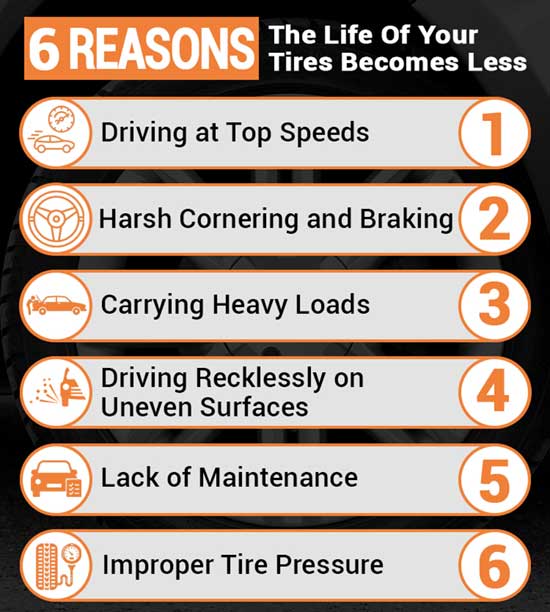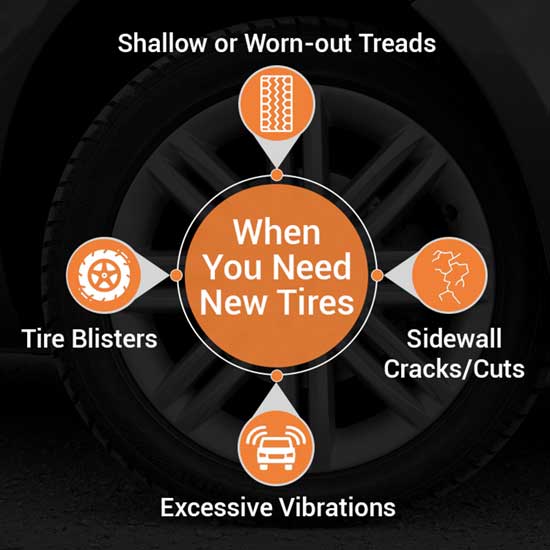As a vehicle owner, you’ve had your fair share of experience with aging tires. Seeing as tires aren’t meant to last for eternity, it begs the question. How old can tires be and still be safe to drive?
When driving, your safety should be your number one priority. Anything that jeopardizes your safety should be checked immediately.
This article will cover all you need to know about tire maintenance, and amongst other questions, how old can tires be and still be safe to drive?
Without further talk, let’s get down to business.
Contents
So, How Old Can Tires Be And Still Be Safe To Drive?
How old can your car tires get and still be good to use? A year? Two years? Maybe six years. A tire that lasts a year or two isn’t much of a quality tire.
Tire experts say that a tire has an average lifespan of six years, after which it should be replaced. However, tires come in different qualities.
Some tires have a treadwear warranty up to 80,000 miles. A longer treadwear warranty will increase the lifespan of your tire. Also, other tires might have a much lower treadwear warranty, implying they’ll have a shorter lifespan.
It is said that the average American drives an average of 14,000 to 15,000 miles yearly. Using this analysis, you can estimate just how long you can drive safely by comparing it with your tire’s treadwear warranty.
Your tire is considered safe for use between one to six years, provided you drive in the right conditions. Keep in mind that regardless of tread depth, old tires can be dangerous.
What Shortens The Life Of Your Tires?
Buying high-quality tires are great and would serve in the long run. However, getting these top-notch tires isn’t a license to abuse them. Some factors can shorten the lifespan of your tires, and we will be discussing them below.

1. Driving at Top Speeds
I’m sure you’ve heard the phrase “speed kills”. In this case, with tires, speed does kill. How? Excessive driving at top speeds will cause your tires to overheat. Overheating will cause your tires to wear prematurely.
2. Harsh Cornering and Braking
The fast and furious movies make harsh cornering and braking look cool; however, in the real world, speedily taking corners will significantly damage the edges of your front tires. This implies that you should approach corners gently to spare your tires the stress.
3. Carrying Heavy Loads
Tires have a maximum load rating, and going beyond it will weaken your tires. How? Excess weight on your vehicle’s tires will increase its pressure levels which is not good for your tire.
4. Driving Recklessly on Uneven Surfaces
Bad terrain is not the place to test your speed limit. Reckless driving on rocky, muddy, or unpaved roads could damage your tires. You are advised to desist from that if you want your tire to last.
5. Lack of Maintenance
The single most effective way to prolong your tire’s lifespan is to maintain it properly. A lack of maintenance will cause your tire to deteriorate quickly.
6. Improper Tire Pressure
Not sticking to the recommended tire pressure will cause improper road contact with your tires. Improper tire pressure will increase friction, causing your tires to overheat.
As we mentioned earlier, overheating is not good for your tires. To avoid this, you could check your tire pressure regularly.
How To Tell When You Need New Tires?
An old tire comes with its problems, and knowing when to get a new set is key. Below are a few signs indicating you need a new tire.

1. Shallow or Worn-out Treads
One obvious sign that you need a new tire is when you have shallow or worn-out treads. A tire is considered due for a change if its tread is worn down to 2/32 of an inch. In many states, driving on the insufficient tread is a crime because it puts you and the general public at risk.
You can use a penny ( Lincoln head penny) and put Abe’s head into your tire treads. If you can see Lincoln’s entire head, it means that you have insufficient tread and need new tires.
2. Sidewall Cracks/Cuts
If you notice cracks on your tires’ sidewalls, it’s time to change your tires as it could result in leakage or worse. Sidewall cracks are easily noticeable on your tires, so long as you’re observant, you should notice it.
3. Blisters on The Tire
With an old tire, you will notice its outer surface gradually get weaker. This weakness will result in bulges or blisters of your tire’s surface. If not taken care of immediately, it may result in a tire blowout. Just like cracks, you can easily notice these blisters or bulges on your tire without the help of an expert.
4. Excessive Vibrations
Having vibrations when driving is normal; however, you can tell when the vibration level is abnormal if you aren’t new to driving.
Several factors can cause your vehicle to vibrate abnormally, and a faulty tire is one of them. If you begin to have these unusual vibrations when driving, your tires are a good place to start your probe.
How to Maintain Your Tires to Make Them Last Longer?
As we said earlier, proper maintenance of your tire will help it last even longer. Below we have provided you with some important maintenance tips that’ll guarantee a long-lasting tire.
- Check your tire air pressure regularly (monthly preferably)
- Ensure that your wheels are balanced
- Check your alignment at least twice a year
- Rotate your tires after 5,000 miles to ensure they don’t wear unevenly
- Regularly inspect your tire treads
- Do not carry weights that exceed your tires weight limit
- Avoid reckless driving on bad terrain
Conclusion
If you are reading this section, it means your question has been answered. Thanks to this article, you now know how old a tire can be to be safely driven on and more.
How about you take a walk to your garage and examine your tires with the information you now know. They say knowledge is power; knowing when to change your tires can save you a lot of trouble, including your life.
We’ll say this once more; your safety should be your number one priority when driving.
